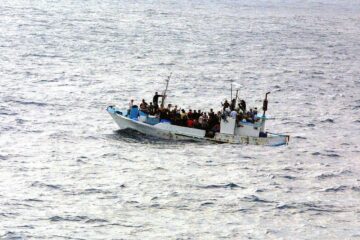![]()
Introduction:
Over the centuries it has been observed throughout the world that societies have always welcomed the frightened and weary strangers and also the victims of violence and persecution. Though people flee from all those threats to their liberty and lives, the Government over the countries finds it difficult to fulfil the obligations related to political realities and domestic needs of these people. Also, it becomes hard for the government to reconcile the humanitarian rights and impulses of these people. Over the world, many countries have invited refugees from the globe to settle in their territory permanently.
Whenever the refugees are seen as a competitor for economic and natural resources have occurred in the country, the tension between the local population and refugees are seen to erupt. Government of many countries have resorted to the method of detention for those illegal entrants including children and women, people who are seeking shelter in an asylum. The aim behind this action in some countries was to discourage these refugees from applying for the status of a refugee while some countries did this because it appeared as an effective way in front of the government to manage these illegal entrants while their identity and status as a refugee are being explored and it also helps for the removal of those entrants who have no grounds for their stay.
Causes for refugee crisis include civil war and war, violation of human rights, environment and climate and economic-based hardship. It also includes gender-based violence and exploitation of displaced people.
Refugees: Meaning
Refugees are defined as “owing to well-founded fear of being persecuted for reasons of race, religion, nationality, membership in a particular social group, or political opinion, is outside the country of his nationality, and is unable to or, owing to such fear, is unwilling to avail himself of the protection of that country”[1]
This term “refugee” includes the population who are displaced because they fall out of the legal definition given in the Convention either because of the reason that they have left their home due to war or they are being forced to migrate within the territory of their home country.
Refugees are defined as a “legal group” when a large number of people flee Eastern Europe following World War II. United Nationals High Commissioner for Refugees (UNCHR) is the lead international agency which coordinates refugees. In the year 2006, it counted that there are almost 28.4 million refugees existing worldwide and 15.1 million in 2011.
Refugee Crisis in Asia and Africa
Asia is recognised as a region over the world which hosts a large population of the refugees but it is also a territory in which international refugee laws are not developed or well-known. According to the statistics provided by UNHCR, this region consists of around 7.7 million refugees out of which half of them are from Myanmar and Afghanistan. In Asia, many states are known to have rejected the 1951 Refugee Convention which was seen by them as a western measure that is intended for the protection of the refugees in European context post World War II. Although this perception no longer stands valid, it still endures in Asia where the ratification rate of Convention is known to be low. However maximum states have signed up for the instruments of basic human rights for the refugees such as the right to not to send them back to the place where they came from where they face a threat to their life and non-refoulement. These also include Internati9onal Covenant on Civil and Political Rights and Convention against torture or inhuman behaviour.
Many states consider that their primary role towards refugee is to provide temporary “humanitarian” assistance. They follow the international community to provide “resettlement” as a permanent solution.
In Asia, the refugee crisis is mostly seen in Afghanistan, Pakistan, Southeast Asia, Uzbekistan, Nepal and India.
Africa is known to have 18.6 million migrants which include 3.7 million refugees that are forced migrants and 11.8 million refugees that are internally displaced people out of the total population of 1.1 billion people. Also, 11.4 million migrants that are from Africa are found outside of the continent.
Since the 1950s, ethnic strife and civil wars are suffered by many African nations which lead to the generation of a huge number of refugees from different ethnic groups and nationalities. The number increased drastically in between 1968 and 1992 from 860,000 to 6,775,000 which later dropped to 2,748,400 in 2004 according to UNHCR. Many refugees here cross into the neighbouring countries in order to find a haven. African countries are considered to be origin for refugees and asylum for other refugees. The maximum population of refugees in 2004 are from Sudan who fled after the Sudanese Civil War and is located in Ethiopia, Chad, Kenya and Uganda.
In Africa, the refugee crisis is mostly seen in Algeria, Angola, Uganda, Great Lakes, Darfur, Nigeria, Central African Republic, Sudan, South Sudan, Somalia, Western Sahara and Libya.
Steps Taken for Refugee Protection
Executive Committee of the High Commissioner’s Program (EXCOM) is a committee that is responsible for approving of the program and budget by UNHCR and also provides advice to it. There are 102 members in the committee. It adopts consensus resolution known as “Conclusions on International Protection”. While they are legally non-binding but these conclusions have a ”strong political authority”[2] which are important when dealing with Asian Pacific countries that are not in Refugee Convention or Protocol but they are members of EXCOM such as India, Thailand, Pakistan and Bangladesh.
Asian-African Legal Consultative Organization or AALCO is an organization that has 47 members and it advises them on the matters related to International Law. Bangkok Principles on Status and Treatment of Refugees was adopted by this organization in 1966 and later in 1970 it adopted Bangkok Principles which deals with “right to return”. In 1987, this organization adopted another addendum which deals with “principles of burden-sharing”. It also later considered Revised Bangkok Principles in 2001 but unfortunately, it had no visible impact on the practice of the state.
In 1967, the Association of South-East Asian Nations (ASEAN) was established which is an inter-governmental organization. In 2012 it adopted ASEAN Human Rights Declaration, Article 16 of this Declaration states that “Every person has the right to seek and receive asylum in another State in accordance with the laws of such State and applicable international agreements”. But members of ASEAN are still reluctant to insert issues related to Asylum seekers in its formal agenda due to the perception that this step would lead to the breach of Charter principle which includes non-interference of ASEAN in its member’s internal affairs.
Conclusion
It can be concluded that the refugee crisis in Asia and Africa are still not resolved. Even after many steps taken by its government, this issue still stays unresolved. Because of these crises, the people in the population of the refugee has to suffer humiliation and violence in the countries where they’ve come to take shelter in. Governments should take into consideration the basic human rights of the refugees and should try to protect them from any inhuman behaviour. Their life along with their dignity and liberty should be protected.
References:
[1] 1951 Convention Relating to the Status of Refugees, Article 1(2)
[2] James Hathaway, The Rights of Refugees under International Law, 113-4.



0 Comments